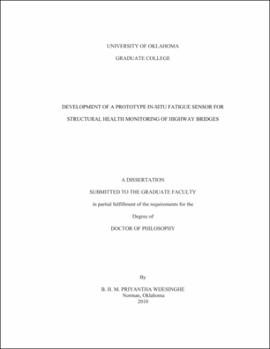| dc.contributor.advisor | Mish, Kyran D||Baldwin, James D | |
| dc.creator | Wijesinghe, B. H. M. Priyantha | |
| dc.date.accessioned | 2019-04-27T21:33:03Z | |
| dc.date.available | 2019-04-27T21:33:03Z | |
| dc.date.issued | 2010 | |
| dc.identifier | 9928909302042 | |
| dc.identifier.uri | https://hdl.handle.net/11244/318989 | |
| dc.description.abstract | Fatigue damage to bridges has been identified as a threat to bridge safety. Fatigue cracks usually occur at stresses lower than the anticipated design stress levels. Unlike yielding or corrosion, fatigue cracks are seldom visible enough to be detected by visual inspection and therefore can be easily overlooked. Since a larger portion of the life of a structure is spent on crack initiation (as opposed to crack propagation), it is vital to develop methods to detect fatigue crack initiation. | |
| dc.description.abstract | Unfortunately, most of the methods that are developed to detect fatigue cracks do not accommodate crack initiation and are not sensitive enough to detect fatigue nucleation. A prototype in-situ fatigue senor has been developed to detect nucleation of fatigue damage in steel highway bridges. | |
| dc.description.abstract | The in-situ fatigue sensor is designed to be bonded to the base structure and is based on the strain-life fatigue analysis method. Sensors are constructed of electrically conductive material with notched sensor arms producing varying stress concentration factors. The sensor operates on the principle of predictable progressive failure of the parallel arms as fatigue damage is accumulated in the base structure. Experimental results of the behavior of the fatigue sensor under constant amplitude loading and variable amplitude loading of a base structure-mimicking carrier specimen are compared with the simulation results obtained by the finite element analysis method and show reasonable agreement. | |
| dc.format.extent | 175 pages | |
| dc.format.medium | application.pdf | |
| dc.language | en_US | |
| dc.relation.requires | Adobe Acrobat Reader | |
| dc.subject | Iron and steel bridges--Fatigue | |
| dc.subject | Steel, Structural--Cracking | |
| dc.subject | Detectors | |
| dc.title | DEVELOPMENT OF A PROTOTYPE IN-SITU FATIGUE SENSOR FOR STRUCTURAL HEALTH MONITORING OF HIGHWAY BRIDGES | |
| dc.type | text | |
| dc.type | document | |
| dc.thesis.degree | Ph.D. | |
| ou.group | College of Engineering::School of Civil Engineering and Environmental Science | |
